Globalization, a construct which links different areas like culture, environment, economy and religion. One reason for this movement is the technical progress.
Ayatollahy primarily deals with the possibilities of the
globalization in terms of religions. According to him religion belongs to the
human culture and because of this it is important to take a closer look at this
issue. Ayatollhy points out that people don’t
have to accept the globalization passively. They have the chance to
participate.
 |
| Picture 1 |
In the following Ayatollahy refers
again and again to the Islam, which is characterized not only by faith but also
as social obligations include a religious theory of law. Everyday things become to
spiritual activities and the globalization provides several ways to do hits,
like the Itjehaad, which tries to make the divine compatible with the current
situation,
In the course he approaches a lot
of good arguments how religion could use the media.The new technologies open new
possibilities for religion, for example to become omnipresent via internet.
Religion can also be used as a solution for certain problem like bioethics or
environmental pollution. The globalization and the media give the possibility
to investigate religions at home.
Besides of all the chances there
are a lot of problems. Through the globalization the separation between local
and international areas has disappeared and represents a risk for some
religions. Furthermore some of the old traditions have been destroyed through
the globalization and as a result two generation could arise. Beside of these
points the globalization weakened moral values; therefore religions should
remove a moral structure.
 |
| Picture 2 |
These are only some of Ayatollahy’s
issues. In general he has many good arguments, but he focuses heavily on the
Islam and leaves out other religions. The article is divided very clear by
different arguments.
This topic shows that religion
has reached the limits of national boundaries and that the religions interact
in a competition. By the globalization new problems appear, for example the
question if a Muslim teacher is allowed to teach in the headscarf. In addition
to Ayatollahy’s article religion have made their benefits through the media and
the new technologies, like the presentation of their own religion via Internet.
Also the influence of religion on other areas, for example in bioethics, where
members of religions take part in bioethical commissions combined with medics.
Tony Blair summarize the recent situation quite clearly: 'These are times of tumultuous change. The twentieth century order is
history; and the forces of globalization are pushing all of the
economies of the world – and all of the citizens of the world, with
their great diversity of religious faiths – more closely together.'
Reference:
Ayatollahy H. 2008. The Role of Media in the Threats and
Opportunities of Globalization for Religion. Journal of Media and Religion 7(1): 34-44.
Picture 1: Leoni AG: http://www.leoni.com/Rechtliche-Hinweise.123.0.html .
Picture 2: http://stopceta.ca/@images/globalization-machine.png .
http://faithandglobalization.yale.edu/.



